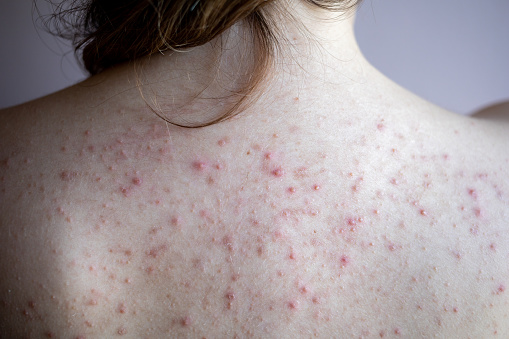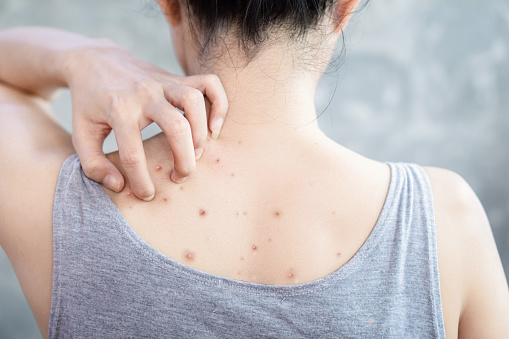As soon as we think about acne, we think about face acne, but acne is unfortunately not limited to the face. Acne is developed whenever your oil-secreting glands are secreting too much oil (if that makes sense); an excess of sebum is what usually causes acne.
You can develop acne on your face, chest, shoulder, back, but – almost anywhere. This article will address the issue that many people face but not so much talk about – back acne, also known as acne.
How Is It Developed?

Back acne is caused by an accumulation of dead skin cells and oil within the pores of the skin and an overgrowth of Cutibacterium acnes, a common skin bacteria that causes an inflammatory reaction.
There are various causes of acne; it can be a new beauty product, sports (sweats), or friction of clothing.
Different Type Of Acne
Whiteheads, also known as closed comedones, arise when a blocked follicle remains closed beneath your skin, leaving a white lump.
A blackhead, also known as an open comedone, is formed when a blocked follicle on the surface of your skin opens. Blackheads have a black-tip look owing to a reaction between sebum and air, not because dirt has gotten into your follicle.
Papules are acne lesions that appear as little pink pimples on your skin and are occasionally uncomfortable. When a blocked hair follicle becomes irritated, this type of acne develops without pus.
Inflammation in a plugged hair follicle can also cause these lesions. A pustule often called a pimple, is a pus-filled papule with a reddish base. The pustule fills with pus due to a buildup of white blood cells.
When bacteria become caught in a hair follicle, a nodule is developed. These lesions begin deep beneath your skin’s surface, where they solidify and create a big, painful nodule. The lesion’s deeper position causes tissue damage, triggering an inflammatory response.
When bacteria become trapped in a hair follicle, cysts form bigger, pus-filled acne lesions. The infection spreads deeper into the skin with cystic acne, resulting in a painful lump that can leave a permanent scar.
How To Prevent Bacne?

It is difficult to control ‘bacne’ in some situations as it is genetics or because of hormones. However, there are some simple steps that you can take to reduce bacne development…
You will want to avoid some medications, such as androgens and lithium. As oily skin people are more prone to acne, it is important to reduce oil-based products to get rid of acne.
Take a shower as soon as you are done working out and avoid putting on clothes that will apply pressure on your back skin; prefer loose clothes.
Treatment For Bacne
Over-the-counter acne treatments and gels with chemicals like benzoyl peroxide, resorcinol, salicylic acid, and sulfur can help clear up blemishes and prevent new ones from appearing on the back.
You may want to ask someone to apply the cream or gel to your back to make sure they get the hard-reaching areas.
To avoid clogging your pores, look for body cleansers that state “non-comedogenic” or “oil-free” on the label.
Antibacterial soaps, astringents, and abrasive scrubs are all acne-causing ingredients. Also, when cleaning your skin, be careful. Scrubs, loofas, and exfoliators that are too harsh might harm the skin’s protective layer and exacerbate body acne
If your acne is getting worse, you can see a dermatologist have better treatments that are tailor-made for you. Lets us know in the comments what type of bacne do you have?


